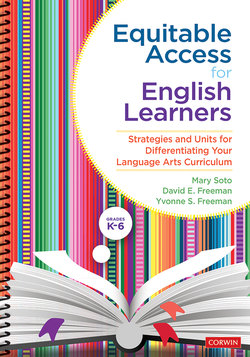Читать книгу Equitable Access for English Learners, Grades K-6 - Mary Soto - Страница 18
На сайте Литреса книга снята с продажи.
Organizing Around Big Question Units of Inquiry
ОглавлениеAs you teach the units in your basal program, you will see that the publisher has chosen readings that are connected to a topic or theme, such as weather or animal habitats. One of the key ways to help English learners understand the readings and acquire needed skills and vocabulary is to help them see the relationships among the readings. You can do this by having the students answer an overarching question as they become involved in the unit. For example, you could ask, “How does the weather affect our lives?” While it is good to make the connections among the readings and activities salient for all your students by linking them to a big question, it is especially critical for students who are not yet proficient in English. There are several reasons you should organize your teaching around units of inquiry based on big questions:
1 Because students see the big picture, the English instruction is more comprehensible.
2 Content areas (math, science, social studies, language arts) are interrelated.
3 Vocabulary is repeated naturally, as it appears in different content area studies.
4 Because the curriculum makes sense, second language learners are more fully engaged and experience more success.
5 Teachers can differentiate instruction to accommodate differences in students’ language proficiency.
6 Through inquiry units, teachers can connect curriculum to students’ lives and backgrounds.
